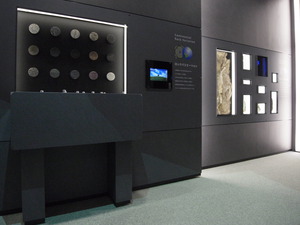Nagoya City Science Museum
TOP > Exhibition Guide > Floor Map> Geosphere -Earth Crust-
Geosphere -Earth Crust-



Purpose of Exhibition
The "Geosphere" is the solid part of the earth.
Additional Knowledge
[Two types of the crust]
The "crust" covers surface of the geosphere like a thin skin. The crust is separated between the continental crust and the ocean crust. Those are named so not just because the former is above sea and the later is below sea, but because their components are different. The continental crust makes appearances on the ocean surface because it is the lightest in the geosphere and has tall ledges like icebergs, which float on the sea.
[The Continental Crust is Complex]
The continent forming mechanism has not been elucidated yet. Simply put, the continental crust was differentiated from the ocean crust sinking into the mantle under a continetal margin or an island arc. It is thought that active island arcs, which are made along with the oceanic trench is the place where the continent crust was formed. It develops the continent by colliding and incorporating. The Japanese island is typical of the island arc.
The continental crust is transformed into several types of rock by being weathered, eroded, deposited, re-pressured and reheated due to surface processes of the earth. However, the continental crusts do not sink because the rocks are lighter than the ocean crust. Therefore, many types and ages of rocks are accumulated and remain in the continental crusts.
[Gems created in the Continental Crust]
It was believed that rock crystal was a compact form of ice. Of course, it is now clear that this belief is wrong. However, rock crystals are minerals created by water. The chemical composition of rock crystal (quartz) is "silica (silicon dioxide)". Silica is a component that almost all of the rock-forming minerals contain, and is easy to dissolve in hot undergournd water. For this reason, when hot underground water is cooled down, oversaturated silica precipitates to form the crystals. A vein of the crystal in rocks is trace of a fracture in which hot water passed through. Such dissolution of rock-forming minerals and precipitation of different minerals in hot water play important roles in mass transfer of materials in the underground environment of the continental crust. On the other hand, some mineral crystals such as ruby and pyrite are found in rock without a fracture. You might not believe that the crystals grow in solid rocks. However, elements diffuse and move in the rock for a long time. If there are micro pores, it is enough for the element to move. Water would help the mobility of aqueous elements. Like this, water plays an important role for the material cycle in the underground.
[Simple Ocean Crust]
Compared with the continental crust, the ocean crust is simple. It is primarily composed of basalt lava covered with organic matter, including dead or dying animals and plants (plankton), protists (diatoms), fecal matter, sand and other inorganic dust. The age of the oldest oceanic crust is only about 200 million years, in contrast to the average continental crust is much older. The place where the ocean crust is formed is chains of submerged undersea volcanoes called "Mid Ocean Ridge". The ocean crust is separated and then the heated subsurface materials rise up to fill in the gap. The mantle substances (peridotite) rise up to the place several dozen kilometers under the seabed and then melt a little, forming tiny droplets of basaltic magma. This is the origin of magma. It rises like needling the gap between the mineral drops, gathers in one place, and finally flows into the seabed. The basalt formed in the mid ocean ridges becomes the ocean plate, which move according to the movement of the plates and then sink in the trench. The further from the ridge, the older ocean crusts are. In other words, the ocean plate is renewed constantly.
[The Seabed Resource]
Three types of mineral resources have been found on the ocean floor. Seafloor hydrothermal deposit is a metal sulfide deposit that includes silver, gold, zinc, lead, and copper, all deposited around the hydrothermal vent "chimney". A Manganese nodule is a spherical or elliptical cluster whose diameter is 2-15 cm. It can be found half buried in the seabed sediment, which includes nickel, copper and cobalt as well as iron and manganese. Cobalt-rich crust is similar to manganese nodule. It has more cobalt and is like a shell several to 10mm thick and covers basalt at the upper part of the seamount. Many unknown creatures have been discovered here. There is a strong possibility of finding yet-unknown and useful microorganisms. The ocean floor is a treasure house for resources.
Article by Shoji Nishimoto, curator
